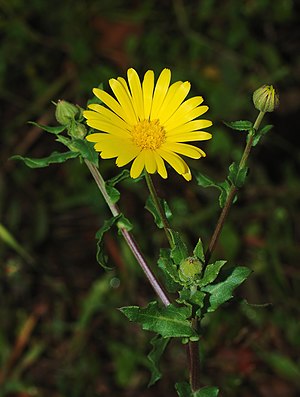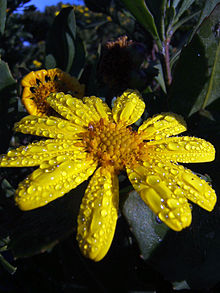Calenduleae
| Calenduleae | ||||||||||||
|---|---|---|---|---|---|---|---|---|---|---|---|---|

|
||||||||||||
| Systematics | ||||||||||||
|
||||||||||||
| Scientific name | ||||||||||||
| Calenduleae | ||||||||||||
| Cass. |
The tribe Calenduleae belongs to the subfamily Asteroideae within the sunflower family (Asteraceae). It contains about twelve plant genera with about 110 to 120 species and thus belongs to the smaller tribe of the Asteraceae.
description



Appearance and leaves
They are mostly one-, two-year or perennial herbaceous plants , rare woody plants: Half bushes , shrubs or trees . Some species are xerophytes .
The usually alternate, sometimes in rosettes, usually distributed on the stem, often against constantly arranged leaves are stalked or sessile, usually with simple, rarely divided leaf blade. The leaf margin is smooth, serrated or sometimes lobed.
Inflorescences and flowers
The cup-shaped inflorescences stand together individually or in branched, umbelliferous whole inflorescences . The sessile or stalked flower heads are disc-shaped. The more or less identical bracts are usually in two, rarely one or three rows; they are mostly free or rarely grown together; they usually have paper-like edges and tips and enclose the flower head, rarely they are fleshy. The flat to seldom conical basket floor is mostly bare, rarely with leaves of chaff . In the basket there are radially symmetrical tubular flowers , so-called disc flowers, and on the edge one to more than two rows of zygomorphic ray- flowers , so-called ray-flowers. In some species there are varieties with more or less filled flower heads; then more until all the flowers are ray florets.
The colors of the petals range from yellow to orange or from white to various shades of blue, sometimes the outside and inside are different colors. The ray-florets are female and fertile with two branches of the style, rarely sterile; the corolla tube is short and the tongue ends in a tridentate. The five-fold, fertile tubular flowers are hermaphroditic or functionally male. Their petals are tubular, funnel-shaped to bell-shaped fused with four or five corolla lobes. There are four or five stamens with a straight stamen tube. The more or less tailed at their base anther own appendage. The stylus has two stylus branches that are sometimes very short at 0.5 to 1 mm. Appendages are recognizable or not on the stylus.
fruit
It is very typical for this tribe that the achenes in a fruit cluster are usually all different in shape and size. The achenes can be straight, curved, curved to ringed (name: marigold!) Or culled; they can be columnar to prismatic, sometimes flattened, sometimes beak-like, sometimes angular, usually with a warty or ribbed, rarely smooth surface. As a specialty, the fruits of Chrysanthemoides are blue-black and stone fruit-like . In this tribe there is very rarely a pappus .
distribution
The tribe Calenduleae has its main distribution in Africa . There are also some species on the Atlantic Islands, Europe (Mediterranean area) and in southwest Asia to Iran as an eastern boundary. There are two centers of biodiversity: the Capensis and the entire Mediterranean. Some species are cultivated as ornamentals around the world and some of them are wild in many areas of the world ( neophytes ).
Systematics
The tribe Calenduleae belongs to the small tribe of the family and contains about twelve genera (previously only eight) with 110 to 120 species:
- Marigolds ( Calendula L. ): It contains around 15 species worldwide.
- Chrysanthemoides Fabr .: The only two types are distributed from the Capensis to eastern Africa.
- Cape marigolds ( Dimorphotheca Moench ): The 19 or so species are distributed from Capensis to Angola .
- Garuleum Cass. : The approximately eight species occur in the Capensis .
- Gibbaria Cass. : The only two species occur in the Capensis .
-
Inuloides B. North. : It contains only one type:
- Inuloides tomentosa (L. f.) B. Nord. : It occurs in the southwestern Capensis.
- Monoculus B.Nord. : The only two species occur in South Africa.
-
Nephrotheca B. North . & Källersjö (genus newly published in 2006): It contains only one species:
- Nephrotheca ilicifolia (L.) B. North . & Källersjö : It appears in the Capensis.
- Norlindhia B. North. : The three or so species occur in South Africa.
- Oligocarpus Less. (formerly in Osteospermum ): Contains one or up to four species.
- Cape basket ( Osteospermum L. ): The approximately 45 species are distributed in Africa and the Arabian Peninsula, 35 of them in the Capensis.
- Tripteris Less. (formerly in Osteospermum ): The approximately 22 species are distributed in Africa and the Arabian Peninsula, 20 of them in the Capensis.
photos
Marigold ( Calendula officinalis ):
The varieties of marigold are both medicinal and ornamental plants .
Cape basket ( Dimorphotheca species):
Flower heads of Dimorphotheca tragus , Syn .: Dimorphotheca aurantiaca with ray and tubular flowers
Flower heads of Dimorphotheca barberae
Bushy cap calendula ( Dimorphotheca sinuata ) in the natural habitat
Osteospermum types:
Flower head of a variety of Osteospermum ecklonis with ray and tubular flowers
swell
- John L. Strother: Calenduleae. In: Flora of North America Editorial Committee (Ed.): Flora of North America North of Mexico . Volume 20: Magnoliophyta: Asteridae, part 7: Asteraceae, part 2 (Astereae, Senecioneae). Oxford University Press, New York / Oxford a. a. 2006, ISBN 0-19-530564-7 , pp. 379 (English). , same text online as the printed work . (Section description)
- Chen Yi-lin, Bertil R. Nordenstam, Charles Jeffrey, Hiroshige H. Koyama, Michele Funston, Debra Trock, Leszek Vincent: Tribe Calenduleae. In: Wu Zheng-yi, Peter H. Raven, Deyuan Hong (Eds.): Flora of China . Volume 20-21: Asteraceae . Science Press / Missouri Botanical Garden Press, Beijing / St. Louis 2011, ISBN 978-1-935641-07-0 , pp. 819 (English). , PDF file , online .
- José L. Panero, Vicki A. Funk: The value of sampling anomalous taxa in phylogenetic studies: major clades of the Asteraceae revealed. In: Molecular Phylogenetics and Evolution. Volume 47, No. 2, 2008, pp. 757-782, DOI: 10.1016 / j.ympev.2008.02.011 , PDF file .
- Bertil Nordenstam: Tribe Calenduleae. In: Kåre Bremer: Asteraceae. Cladistics and Classification. Timber Press, Portland, Oregon 1994, ISBN 0-88192-275-7 , pp. 365-376.
- PPJ Herman, E. Retief, M. Koekemoer, WG Welman: Asteraceae (Compositae). In: OA Leistner (Ed.): Seed Plants of Southern Africa. In Strelitzia. Volume 10, 2000, pp. 101-170.
- Bertil Nordenstam: Tribe Calenduleae. In: Joachim W. Kadereit, Charles Jeffrey (Eds.): The Families and Genera of Vascular Plants . Volume 8: Flowering Plants. Eudicots. Asterales . Springer, Berlin / Heidelberg / New York 2007, ISBN 978-3-540-31050-1 , pp. 241–245 (English, limited preview in Google Book Search).
- Tribe Calenduleae. Genera native to southern Africa at the Biodiversity Explorer of the Iziko Museum of Cape Town.
Individual evidence
- ↑ Bertil Nordenstam: Tribe Calenduleae. In: Kåre Bremer: Asteraceae. Cladistics and Classification. Timber Press, Portland, Oregon 1994, ISBN 0-88192-275-7 , pp. 365-376.
- ↑ PPJ Herman, E. Retief, M. Koekemoer, WG Welman: Asteraceae (Compositae). In: OA Leistner (Ed.): Seed Plants of Southern Africa. In Strelitzia. Volume 10, 2000, pp. 101-170.
- ↑ a b c d e f g h Tribe Calenduleae. Genera native to southern Africa at the Biodiversity Explorer of the Iziko Museum of Cape Town. ( Memento of the original from February 24, 2011 in the Internet Archive ) Info: The archive link was inserted automatically and has not yet been checked. Please check the original and archive link according to the instructions and then remove this notice.
- ↑ Species list for Garuleum in the Red List of South African Plants
- ↑ Species list on Osteospermum in the Red List of South African Plants
- ^ List of species on Tripteris in the Red List of South African Plants








